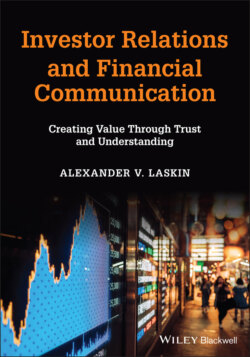Investor Relations and Financial Communication

Реклама. ООО «ЛитРес», ИНН: 7719571260.
Оглавление
Alexander V. Laskin. Investor Relations and Financial Communication
Investor Relations and Financial Communication. Creating Value Through Trust and Understanding
Contents
List of Illustrations
List of Tables
Guide
Pages
1 Introduction to Investor Relations and Financial Communication. Definition
History
Communication Era
Financial Era
Synergy Era
Key Terms
Questions and Activities
2 Investor Relations and Financial Communication Industry. Investor Relations Officers
Other Jobs in Financial Communication
Investor Relations and Financial Communication Agencies
Education and Training
Ethics and Professionalism
Finding a Job in Investor Relations and Financial Communication
Key Terms
Discussion Questions and Activities
3 Stockholders and Stakeholders
Investors: Stockholders
Retail Shareholders
Institutional Investors
Traders
Portfolio Builders
Shareowners
Common vs. Preferred Stock
Value vs. Growth Investors
Investors: Debt Holders
Sell-side
Internal Stakeholders
Other Stakeholders
Key Terms
Discussion Questions and Activities
4 Communicating Financial Information
Income Statement
Balance Sheet
Cash Flow Statement
Statement of Stockholders’ Equity
Financial Analysis
GAAP and Non-GAAP Financial Disclosure
Key Terms
Discussion Questions and Activities
5 Communicating Nonfinancial Information
Defining Nonfinancial Information
Lack of Nonfinancial Disclosure
Future of Nonfinancial Information
Key Terms
Discussion Questions and Activities
6 Legal and Regulatory Environment of Investor Relations and Financial Communication
Securities Act of 1933
Securities Exchange Act of 1934
True Indenture Act of 1939
Investment Company Act of 1940
Investment Adviser Act of 1940
Regulation FD
Sarbanes–Oxley Act of 2002
Dodd–Frank Act of 2010
Jumpstart Our Business Startups Act
Key Terms
Discussion Questions and Activities
7 Corporate Governance, Environmental Sustainability, and Social Responsibility
Environmental Sustainability
Social Responsibility
Corporate Governance
Key Terms
Discussion Questions and Activities
8 Shareholder Activism and Crisis Management
Reasons for Activism
Proxy Battles
Retail Investors
Crisis Management
Hostile Takeover
Bankruptcy
Key Terms
Discussion Questions and Activities
9 Main Activities and Publications in Investor Relations and Financial Communication
Disclosure
Paid Media, Earned Media, Shared Media, and Owned Media
Earnings and Earning Calls
Annual Shareholder Meetings and Proxy Statements
Responsiveness to Investors, One-on-One Meetings, and Relationship Building
Sell-side and Research Coverage
Roadshows, Investor Days, Conferences, and Other Special Events
Internal Activities
Targeting
Key Terms
Discussion Questions and Activities
10 Going Public and Going Private
Initial Public Offering
Follow-on Public Offering
American Depositary Receipt
Direct Listing
Private Listing
Special Purpose Acquisition Company
Going Private
Key Terms
Discussion Questions and Activities
11 Measurement and Evaluation of Investor Relations and Financial Communication
Levels of Evaluation: the Model
The Application of the Levels of Evaluation. IRO/Agency Level: Output
Intermediary/Media Level: Outreach
Target Audience Level: Outcome
Organizational Results Level: Outgrowth
Industry Level: Outperform
Strategic Goal
Key Words
Discussion Questions and Activities
12 Globalization of the Financial Markets and Regional Distinctions. Investments Know No Boundaries
Depositary Receipts: Global Depositary Receipts, American Depositary Receipts, and Euro-denominated Depositary Receipts
Regional Variations in Investor Relations and Financial Communication
Sidebar 12.1. Investor relations in Russia: the case of Bank Vozrozhdenie
Key Terms
Discussion Questions and Activities
13 The Future of Investor Relations and Financial Communication. COVID-19 Accelerates Online Processes
Technological Innovations
Retail Investors
New Investment Vehicles
Growing Regulations
Cybersecurity
Growing Importance of ESG
Sidebar 13.1. Growing importance of professional associations: the case of NIRI
Post-Information Age
Shareholder Activism
Key Terms
Discussion Questions and Activities
Bibliography
Index
WILEY END USER LICENSE AGREEMENT
Отрывок из книги
Alexander V. Laskin,
Quinnipiac University Hamden, Connecticut
.....
Another problem was the track record. The market was growing in leaps and bounds after World War II and shareholders (especially individual shareholders) expected it to continue like this forever. The expectations became too high for the reality to deliver. In other words, “success bred a level of expectations that could not be fulfilled” (Chatlos, 1984, p. 87). The system was destroying itself: the system built on volume of transactions could not handle that volume anymore, and the investors were ready to quit:
Customers were less than happy and did what might have been expected. They walked away. They did not sell their shares. They just walked away. For a system geared to the retail trade – and in many respects it remains so today – it was a devastating blow. The system was geared to volume, couldn’t plan for high volume, and suddenly had very little volume. Again, as could have been expected, broker failures and bankruptcy-avoiding mergers followed. It was a grim sight and the individual shareholder moved further away from the system.
.....